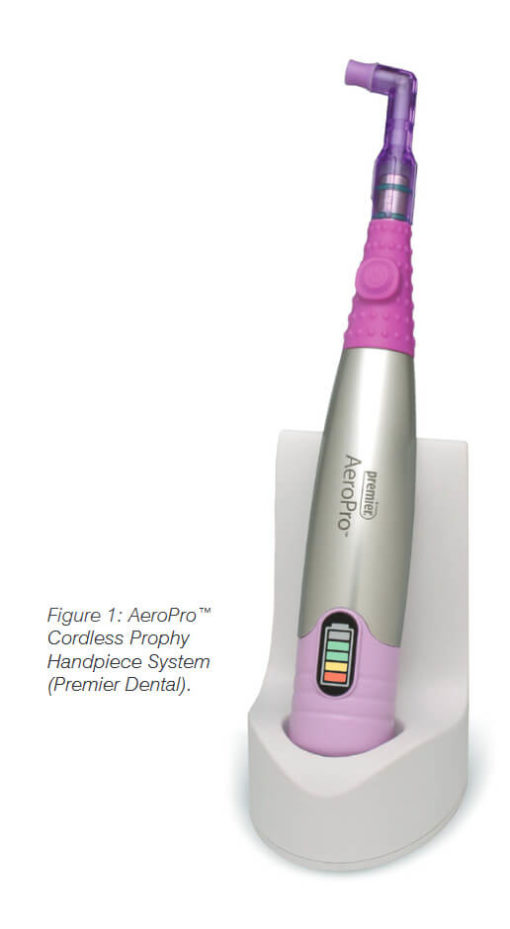
Technology has helped provide solutions for dental hygienists, specifically by the introduction of larger handled instruments and ultrasonic inserts which have more effective tips for better control and pre-cision. However, prophy handpieces have histori-cally been air-driven and decidedly unergonomic with tubing connected to a slow speed motor and straight nose cone. This delivery system can be heavy and create chronic fatigue to the upper ex-tremities, hands, and wrists. Cordless prophy hand-pieces have been introduced to further help dental hygienists combat hand and wrist stress and these benefits were confirmed in a study by McCombs and Russell. They compared the muscle loads required during simulated tooth polishing using a corded versus a cordless handpiece. Electromy-ography (EMG) was used to measure the activity of four muscles involved in high pinch force. The results showed a reduced EMG for three out of the four muscles tested when the cordless handpiece was used, and an average 30-second reduction in polishing time with the cordless handpiece. The dental hygienists preferred the cordless handpiece over the corded handpieces used in the study. When queried as to why, they listed – a lack of cord, less weight, better balance, and low noise – as the main reasons for the preference.
Recently, Clinicians Report conducted a survey of dental professionals using hygiene handpieces. When the respondents were asked to compare, 88% and 90% of the cordless users rated ‘Ease of use’ and ‘Ergonomics’ as better with the cordless versus the corded handpieces, respectively. Among the advantages the report listed were: portable, eliminates cord drag, quieter, and decreased turn-around time through the use of disposable barriers and motor disinfection. The disadvantages includ-ed: the need for custom prophy angles (for some models), limited battery life, and lower speeds (than corded models).
Based on extensive input from dental professionals, Premier Dental recently introduced the AeroPro™ Cordless Prophy Handpiece System. (Figures 1-4) The AeroPro™ system was engineered to provide clinicians with greater mobility, choice, and control; further helping to prevent symptoms of hand and wrist fatigue and to provide a better polishing expe-rience for both operator and patient.
Compatible with most commonly available dispos-able prophy angles, AeroPro™ allows the angle to be easily rotated 360° for improved intraoral access. From Premier’s website, AeroPro™ is “ergonomic and lightweight with a well-balanced design, featur-ing a textured grip for reduced pinch strength and hand fatigue.” It is controlled using a single button, allowing the operator to easily access the most appropriate prophy cup speed for the procedure. AeroPro™’s speeds range from 500-2800 rpm. This reduced speed compared to corded prophy head-pieces (maximum rpm of 5000-6000) may be helpful in reducing the chance of overheating the tooth and causing iatrogenic pulp damage.
AeroPro™ is equipped with ChargeSMART™ Battery Technology. This innovative induction charging sys-tem powers AeroPro’s battery quickly and safely and ensures a long-lasting charge that lasts through a busy workday. It is tested to provide sufficient bat-tery life for completion of a minimum of ten coronal polishing procedures on a full charge, and can be easily placed back on the charging base between patients if additional battery life is needed.
AeroPro™’s convenient infection prevention proto-col is FDA-cleared and CDC-compliant. The motor component is isolated by a custom-fit disposable polyethylene barrier and covered by a durable, metal outer sheath. After use the metal sheath is removed, cleaned, and autoclaved, while the motor component is disinfected using a CDC intermediate level disinfectant.
Closing Thoughts
Because of the nature of clinical dentistry – static posture, precise and repetitive motions, long work hours, and sub-optimal ergonomics – all members of the clinical team are at risk for MSDs. Dental hygien-ists especially may be at an increased risk for MSDs compared to dentists and must practice preventive strategies to maintain hand and musculoskeletal health. Appreciating that an effective dental hygiene program is an integral component of a successful dental practice and comprehensive patient care, hygienists should seek clinical equipment that can reduce muscle workload and duration. Cordless prophy handpieces have evolved to offer clinical performance with the added advantages of portabil-ity, convenience, and no cord drag. They can offer a meaningful innovation over corded predecessors and should be considered a worthwhile upgrade for the safe and ergonomic delivery of hygiene care.
Jason H. Goodchild, DMD is the director of clinical affairs, Premier Dental Products Company, Plymouth Meeting, Pennsylvania; an associate clinical professor, Depart-ment of Oral and Maxillofacial Surgery, Creighton University School of Dentistry, Omaha, Nebraska; an adjunct assistant professor, Department of Diagnostic Sciences, Rutgers School of Dental Medicine, Newark, New Jersey; and in private practice in Havertown, Pennsylvania. He can be reached at: jgoodchild@premusa.com.
REFERENCES:
1. Hayes MJ, Cockrell D, Smith DR. A systematic review of musculoskeletal disorders among dental professionals. Int J Dent Hyg. 2009;3:159-65.
2. Padhye NM, Padhye AM, Gupta HS. Effect of pre-procedural chair-side finger stretches on pinch strength amongst dental cohort – a biomechanical study. J Clin Diagn Res. 2017 Apr;11(4):ZC82-ZC85.
3. Rucker LM, Sunell S. Ergonomic risk factors associated with clinical dentistry. Can Dent Assoc J. 2002;30(2):139-146.
4. McCombs G, Russell DM. Comparison of corded and cordless handpieces on forearm muscle activity, procedure time and ease of use during simulated tooth polishing. J Dent Hyg. 2014;88(6):386-393.
5. Christensen GJ. Continued Advancements in Cordless Prophy Handpieces. Clinicians Report, Dental Hygiene 2019;12(1):1-2.
6. Nield-Gehrig JS. Supplementary Instrumentation. In: Fundamentals of Periodontal Instrumentation & Advanced Root Instrumentation. 2008. Lippincott Williams & Wilkins, Philadelphia, PA. p59




